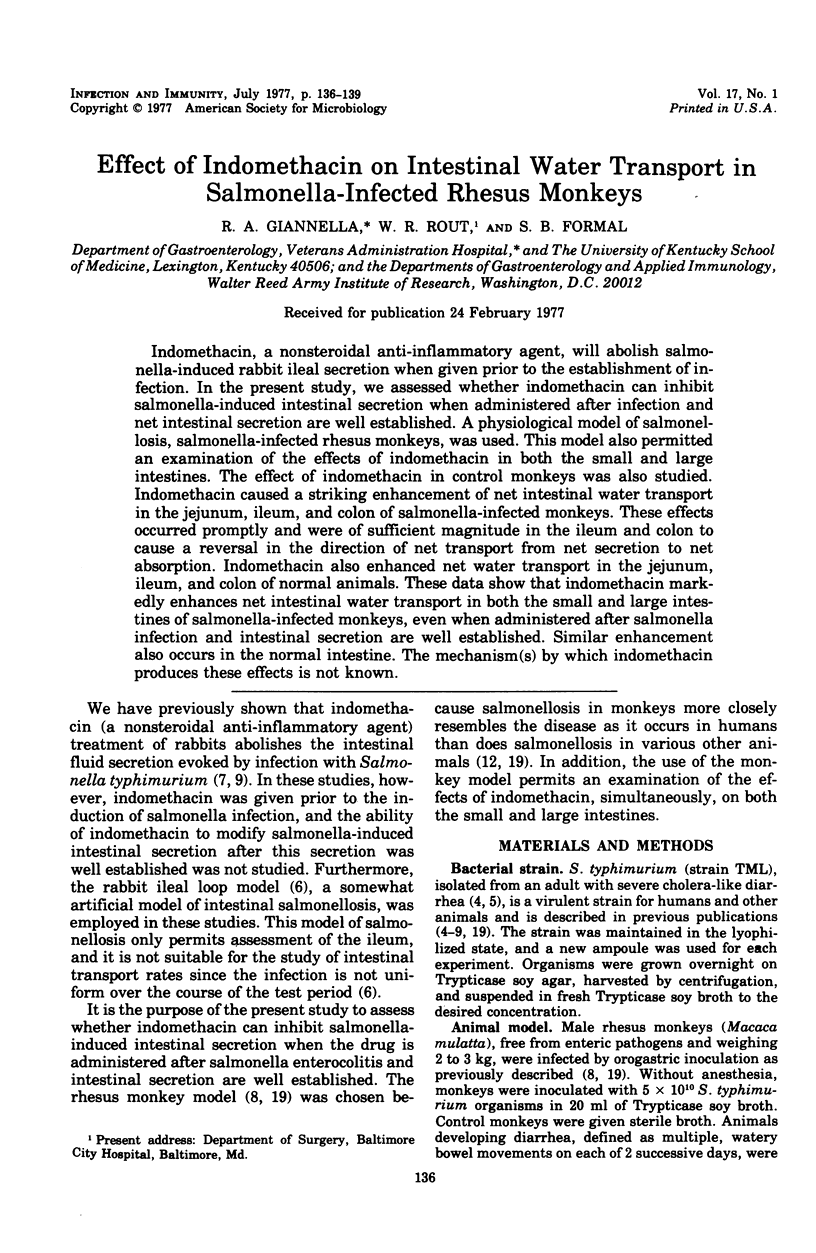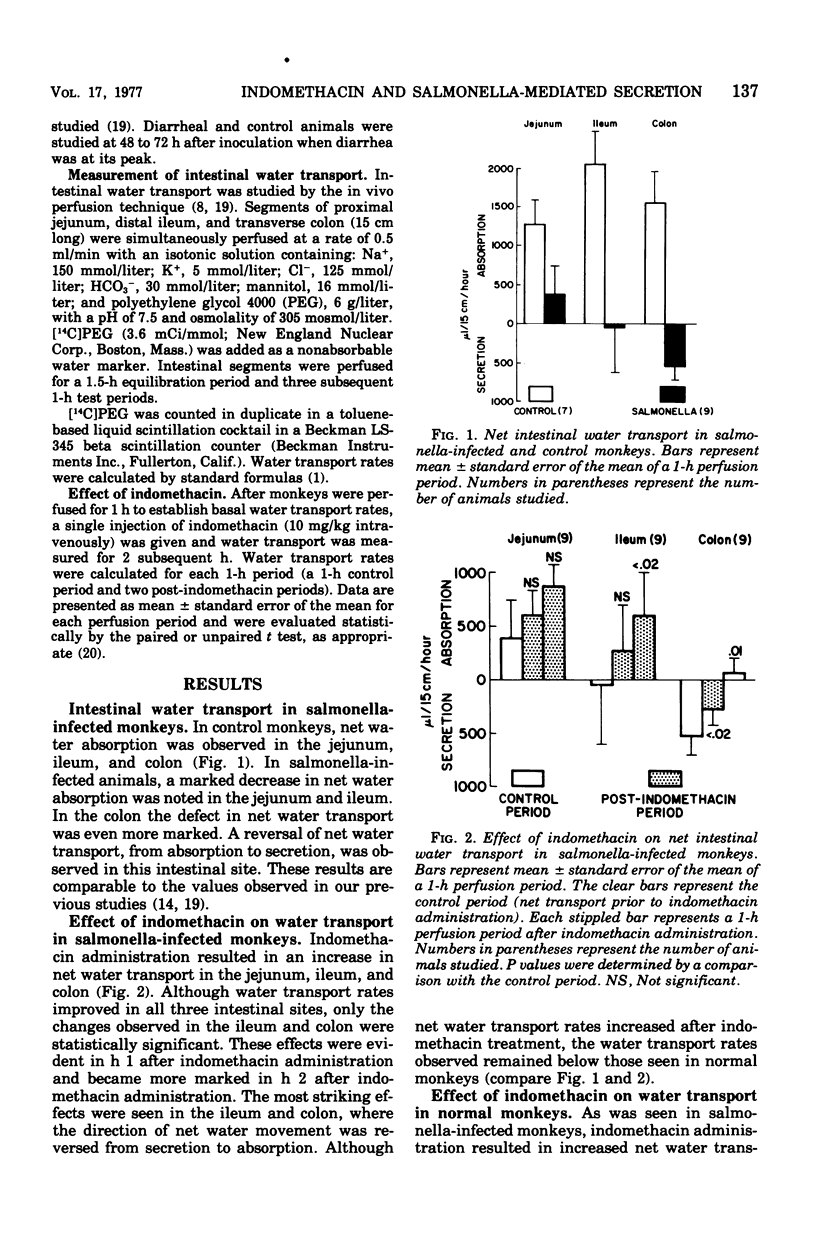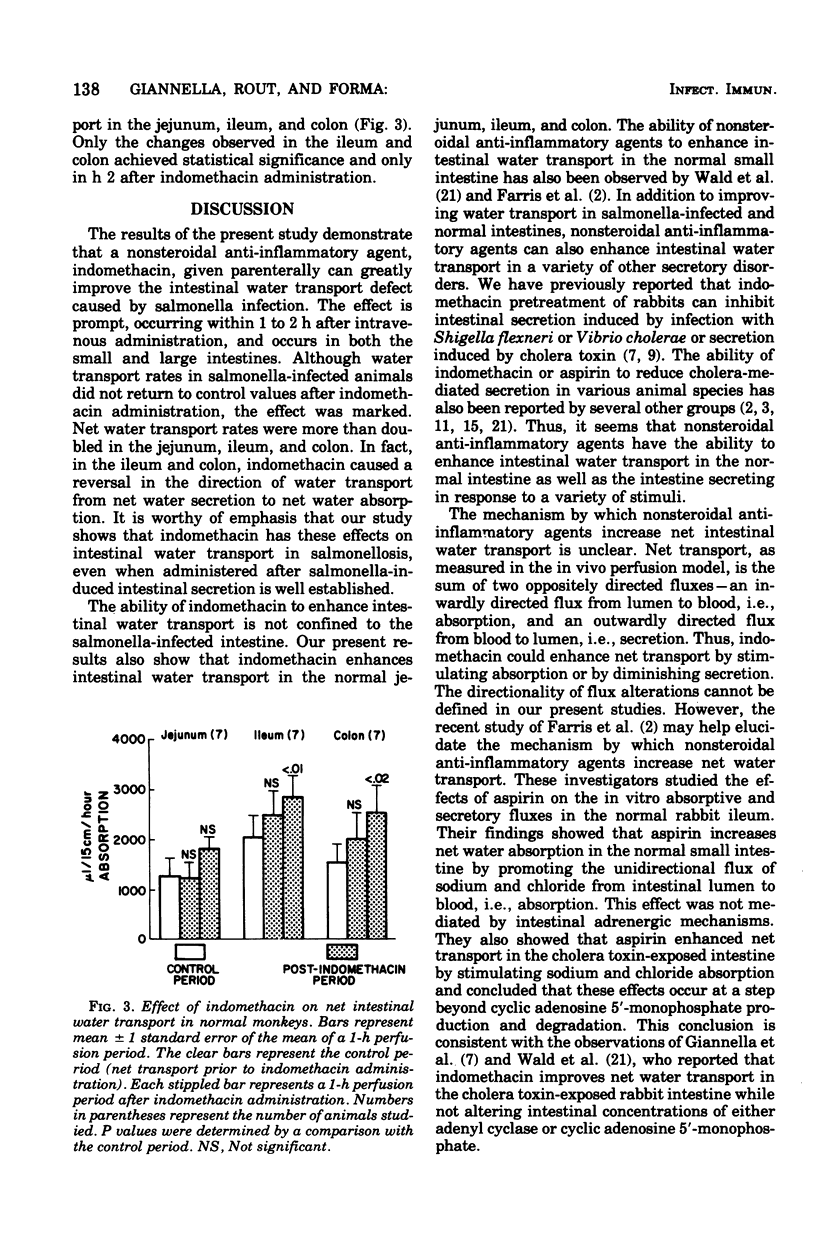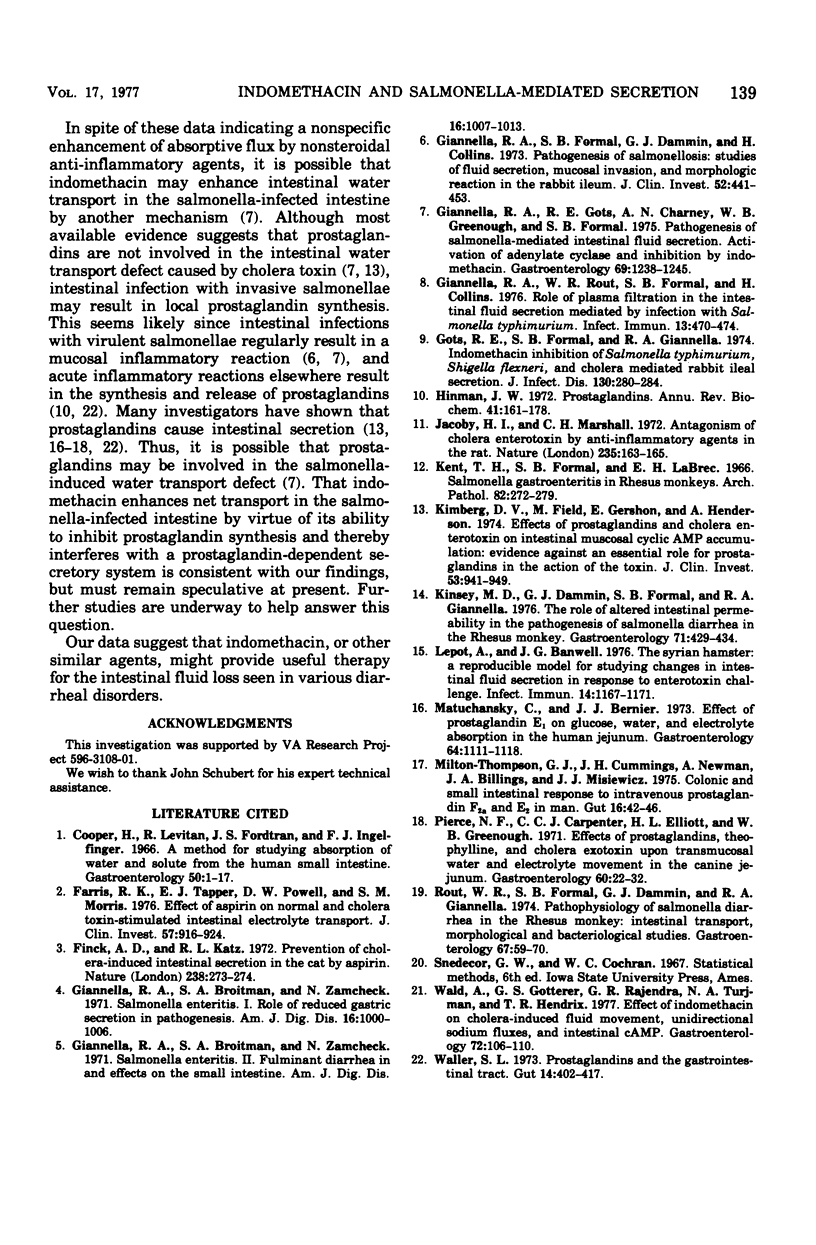Abstract
Indomethacin, a nonsteroidal anti-inflammatory agent, will abolish salmonella-induced rabbit ileal secretion when given prior to the establishment of infection. In the present study, we assessed whether indomethacin can inhibit salmonella-induced intestinal secretion when administered after infection and net intestinal secretion are well established. A physiological model of salmonellosis, salmonella-infected rhesus monkeys, was used. This model also permitted an examination of the effects of indomethacin in both the small and large intestines. The effect of indomethacin in control monkeys was also studied. Indomethacin caused a striking enhancement of net intestinal water transport in the jejunum,, ileum, and colon of salmonella-infected monkeys. These effects occurred promptly and were of sufficient magnitude in the ileum and colon to cause a reversal in the direction of net transport from net secretion to net absorption. Indomethacin also enhanced net water transport in the jejunum ileum, and colon of normal animals. These data show that indomethacin markedly enhances net intestinal water transport in both the small and large intestines of salmonella-infected monkeys, even when administered after salmonella infection and intestinal secretion are well established. Similar enhancement also occurs in the normal intestine. The mechanism(s) by which indomethacin produces these effects is not known.
Full text
PDF



Selected References
These references are in PubMed. This may not be the complete list of references from this article.
- Cooper H., Levitan R., Fordtran J. S., Ingelfinger F. J. A method for studying absorption of water and solute from the human small intestine. Gastroenterology. 1966 Jan;50(1):1–7. [PubMed] [Google Scholar]
- Farris R. K., Tapper E. J., Powell D. W., Morris S. M. Effect of aspirin on normal and cholera toxin-stimulated intestinal electrolyte transport. J Clin Invest. 1976 Apr;57(4):916–924. doi: 10.1172/JCI108368. [DOI] [PMC free article] [PubMed] [Google Scholar]
- Finck A. D., Katz R. L. Prevention of cholera-induced intestinal secretion in the cat by aspirin. Nature. 1972 Aug 4;238(5362):273–274. doi: 10.1038/238273a0. [DOI] [PubMed] [Google Scholar]
- Giannella R. A., Broitman S. A., Zamcheck N. Salmonella enteritis. I. Role of reduced gastric secretion in pathogenesis. Am J Dig Dis. 1971 Nov;16(11):1000–1006. doi: 10.1007/BF02235012. [DOI] [PubMed] [Google Scholar]
- Giannella R. A., Broitman S. A., Zamcheck N. Salmonella enteritis. II. Fulminant diarrhea in and effects on the small intestine. Am J Dig Dis. 1971 Nov;16(11):1007–1013. doi: 10.1007/BF02235013. [DOI] [PubMed] [Google Scholar]
- Giannella R. A., Formal S. B., Dammin G. J., Collins H. Pathogenesis of salmonellosis. Studies of fluid secretion, mucosal invasion, and morphologic reaction in the rabbit ileum. J Clin Invest. 1973 Feb;52(2):441–453. doi: 10.1172/JCI107201. [DOI] [PMC free article] [PubMed] [Google Scholar]
- Giannella R. A., Gots R. E., Charney A. N., Greenough W. B., 3rd, Formal S. B. Pathogenesis of Salmonella-mediated intestinal fluid secretion. Activation of adenylate cyclase and inhibition by indomethacin. Gastroenterology. 1975 Dec;69(6):1238–1245. [PubMed] [Google Scholar]
- Giannella R. A., Rout W. R., Formal S. B., Collins H. Role of plasma filtration in the intestinal fluid secretion mediated by infection with Salmonella typhimurium. Infect Immun. 1976 Feb;13(2):470–474. doi: 10.1128/iai.13.2.470-474.1976. [DOI] [PMC free article] [PubMed] [Google Scholar]
- Gots R. E., Formal S. B., Giannella R. A. Indomethacin inhibition of Salmonella typhimurium, Shigella flexneri, and cholera-mediated rabbit ileal secretion. J Infect Dis. 1974 Sep;130(3):280–284. doi: 10.1093/infdis/130.3.280. [DOI] [PubMed] [Google Scholar]
- Hinman J. W. Prostaglandins. Annu Rev Biochem. 1972;41:161–178. doi: 10.1146/annurev.bi.41.070172.001113. [DOI] [PubMed] [Google Scholar]
- Jacoby H. I., Marshall C. H. Antagonism of cholera enterotoxin by anti-inflammatory agents in the rat. Nature. 1972 Jan 21;235(5334):163–165. doi: 10.1038/235163a0. [DOI] [PubMed] [Google Scholar]
- Kent T. H., Formal S. B., Labrec E. H. Salmonella gastroenteritis in rhesus monkeys. Arch Pathol. 1966 Sep;82(3):272–279. [PubMed] [Google Scholar]
- Kimberg D. V., Field M., Gershon E., Henderson A. Effects of prostaglandins and cholera enterotoxin on intestinal mucosal cyclic AMP accumulation. Evidence against an essential role for prostaglandins in the action of toxin. J Clin Invest. 1974 Mar;53(3):941–949. doi: 10.1172/JCI107635. [DOI] [PMC free article] [PubMed] [Google Scholar]
- Kinsey M. D., Dammin G. J., Formal S. B., Giannella R. A. The role of altered intestinal permeability in the pathogenesis of salmonella diarrhea in the rhesus monkey. Gastroenterology. 1976 Sep;71(3):429–434. [PubMed] [Google Scholar]
- Lepot A., Banwell J. G. The Syrian hamster: a reproducible model for studying changes in intestinal fluid secretion in response to enterotoxin challenge. Infect Immun. 1976 Nov;14(5):1167–1171. doi: 10.1128/iai.14.5.1167-1171.1976. [DOI] [PMC free article] [PubMed] [Google Scholar]
- Matuchansky C., Bernier J. J. Effect of prostaglandin E 1 on glucose, water, and electrolyte absorption in the human jejunum. Gastroenterology. 1973 Jun;64(6):1111–1118. [PubMed] [Google Scholar]
- Milton-Thompson G. J., Cummings J. H., Newman A., Billings J. A., Misiewicz J. J. Colonic and small intestinal response to intravenous prostaglandin F2 alpha and E2 in man. Gut. 1975 Jan;16(1):42–46. doi: 10.1136/gut.16.1.42. [DOI] [PMC free article] [PubMed] [Google Scholar]
- Pierce N. F., Carpenter C. C., Jr, Elliott H. L., Greenough W. B., 3rd Effects of prostaglandins, theophylline, and cholera exotoxin upon transmucosal water and electrolyte movement in the canine jejunum. Gastroenterology. 1971 Jan;60(1):22–32. [PubMed] [Google Scholar]
- Rout W. R., Formal S. B., Dammin G. J., Giannella R. A. Pathophysiology of Salmonella diarrhea in the Rhesus monkey: Intestinal transport, morphological and bacteriological studies. Gastroenterology. 1974 Jul;67(1):59–70. [PubMed] [Google Scholar]
- Wald A., Gotterer G. S., Rajendra G. R., Turjman N. A., Hendrix T. R. Effect of indomethacin on cholera-induced fluid movement, unidirectional sodium fluxes, and intestinal cAMP. Gastroenterology. 1977 Jan;72(1):106–110. [PubMed] [Google Scholar]
- Waller S. L. Prostaglandins and the gastrointestinal tract. Gut. 1973 May;14(5):402–417. doi: 10.1136/gut.14.5.402. [DOI] [PMC free article] [PubMed] [Google Scholar]


